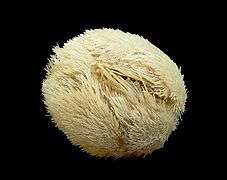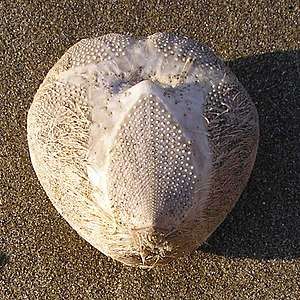Echinocardium cordatum
Echinocardium cordatum, or the sea potato,[2] is a sea urchin in the family Loveniidae. It is found in sub-tidal regions in temperate seas around the world and lives buried in the sandy sea floor.
| Echinocardium cordatum | |
|---|---|
 | |
| Belgian continental shelf specimen | |
| Scientific classification | |
| Kingdom: | |
| Phylum: | |
| Subphylum: | |
| Class: | |
| Order: | |
| Family: | |
| Genus: | |
| Species: | E. cordatum |
| Binomial name | |
| Echinocardium cordatum | |
| Synonyms | |
| |
Description

The sea potato is a heart-shaped urchin clothed in a dense mat of furrowed yellowish spines which grow from tubercles and mostly point backwards. The upper surface is flattened and there is an indentation near the front. This urchin is a fawn colour but the tests that are found on the strandline have often lost their spines and are white. During life, the spines trap air which helps prevent asphyxiation for the buried urchin.[3] The ambulacra form a broad furrow in a star shape extending down the sides of the test. There are two series each of two rows of tube feet. The test reaches from six to nine centimetres in length.[2]
Distribution
The sea potato has a discontinuous cosmopolitan distribution. It is found in temperate seas in the Adriatic Sea,[4] the north Atlantic Ocean, the west Pacific Ocean, around Australia, New Zealand, South Africa and the Gulf of California at depths of down to 230 metres.[1] It is very common round the coasts of the British Isles in the neritic zone.[5]
Biology
The sea potato buries itself in sand to a depth of ten to fifteen centimetres. It occurs in sediments with a wide range of grain sizes but prefers sediments with a size of 200 to 300 µm and a low mud content.[6] It makes a respiratory channel leading to the surface and two sanitary channels behind itself, all lined by a mucus secretion.[1] The location of burrows can be recognised by a conical depression on the surface in which detritus collects. This organic debris is used by the buried animal as food and is passed down by means of the long tube feet found in the front of the ambulacrum.[5]
The sexes are separate in the sea potato and the males and females both liberate gametes into the water table in the spring. The echinoplutei larvae that develop after fertilisation have four pairs of arms and are laterally flattened. In late stage larvae, tube feet may be seen developing round the skeleton.[7] The larvae are pelagic and form part of the zooplankton. Metamorphosis takes place about 39 days after fertilisation with the larvae settling out and burrowing into the substrate.[8] The lifespan of the sea potato is thought to be ten or more years.[9]
Ecology
In the sandy sea bed that it favours, the sea potato is often found in association with the bivalve molluscs Tellina fabula, Ensis ensis and Venus striatula.[10]
The bivalve Tellimya ferruginosa is often found living inside the sea potato's burrow as a commensal. Up to fourteen have been found in one burrow with the young being attached to the spines of the urchin by byssus threads.[11] Another species that makes use of the burrow is the amphipod crustacean, Urothoe marina.[12]
References
- World Register of Marine Species
- "Sea potato (Echinocardium cordatum)". The Marine Life Information Network. MarLIN. Retrieved 21 July 2018.
- European Marine Life
- National Museums of Northern Ireland
- Degraer S., J. Wittoeck, W. Appeltans, K. Cooreman, T. Deprez, H. Hillewaert, K. Hostens, J. Mees, E. Vanden Berghe & M. Vincx (2006). The macrobenthos atlas of the Belgian part of the North Sea. Belgian Science Policy. D/2005/1191/3. ISBN 90-810081-6-1. 164 pp.
- Zimnes: Echinopluteus larva
- Kashenko, S.D., (1994). Larval development of the heart urchin Echinocardium cordatum feeding on different macroalgae. Biologiya Morya, 20, 385-389.
- Buchanan, J.B., (1966). The biology of Echinocardium cordatum (Echinodermata: Spatangoidea) from different habitats. Journal of the Marine Biological Association of the United Kingdom, 46, 97-114.
- Elements of Marine Ecology
- Fish, J.D. and Fish, S., (1996). A student's guide to the seashore. Second edition. Cambridge: Cambridge University Press.
- Hayward, P.J. & Ryland, J.S. (ed.) (1995b). Handbook of the marine fauna of North-West Europe. Oxford: Oxford University Press.
.jpg)
.jpg)